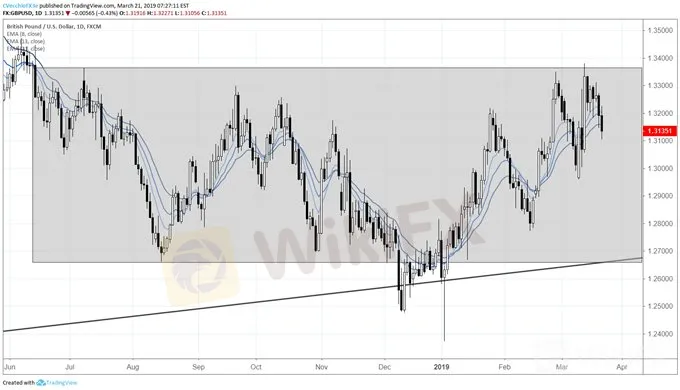简体中文
繁體中文
English
Pусский
日本語
ภาษาไทย
Tiếng Việt
Bahasa Indonesia
Español
हिन्दी
Filippiiniläinen
Français
Deutsch
Português
Türkçe
한국어
العربية
GBPUSD Price Limited as BOE Remains Sidelined by Latest Brexit News
Abstract:The latest Brexit developments are in control of the British Pound, leaving the Bank of England sidelined.
It should come as no surprise to anyone that the Bank of England kept rates on hold today. Such an economic and/or financial environment wrought with interference from UK domestic politics has left little room for the BOE's Monetary Policy Committee to operate, one way or the other. The reaction by GBPUSD says it all: within the first 10-minutes of the announcement, the range was a mere 20-pips between 1.3108 and 1.3128.
Expectations were Low for the BOE Meeting
According to overnight index swaps, rates markets were pricing in a 0% chance of a move in either direction today. After the March BOE meeting, rates markets were pricing in a 17% chance of a 25-bps rate hike and a 2% chance of a 25-bps rate cut by the end of the year. In other words, the rate outlook has been and remains neutral.
Brexit Latest – Extension Likely, but Not Guaranteed
With the specter of a potential no deal, “hard Brexit” lingering as the March 29 deadline approaches, UK PM Theresa May finds herself pleading with EU officials in Brussels for an extension. While EU officials have been open to the idea of an extension, we havent seen the UK and EU come eye-to-eye yet on an exact date. The issue of the EU parliamentary elections in early-July is in play, as the EU would prefer to have the UK out of the union before the elections take place.
GBPUSD Price Chart: Daily Timeframe (June 2018 to March 2019) (Chart 1)

While implied volatility levels have started to spike for various GBP-crosses, perhaps taking a step back and looking at the big picture is more important. After all, since the bearish outside engulfing bar set on June 14, 2018, GBPUSD has spent more than 92% of its time trading between 1.2660 and 1.3365 (that is, price was within said range at some point during the trading day).
With all of the Brexit headlines swirling about, traders may feel that its best to wait for definitive news and a definitive range break before staking out a significant position.
Disclaimer:
The views in this article only represent the author's personal views, and do not constitute investment advice on this platform. This platform does not guarantee the accuracy, completeness and timeliness of the information in the article, and will not be liable for any loss caused by the use of or reliance on the information in the article.
Read more

KVB Market Analysis | 5 August: Gold Declines in Early Asian Session Amid Profit-Taking and Market Uncertainty
Gold declined in the early Asian session due to profit-taking after hitting a record high on Friday. The US NFP report showed only 117K new jobs in July, below the expected 175K, signaling a potential increase for XAU/USD. Annual wage growth slowed to 3.7%, easing inflation fears and boosting Fed rate-cut prospects. Rising tensions between Iran and Israel have also increased gold’s safe-haven appeal.

XAU/USD Post-CPI Data Analysis
Gold prices surged post-CPI data, hitting a third consecutive weekly gain and surpassing $2,400, driven by expectations of Fed rate cuts. Positive sentiment and global economic uncertainty boost gold's appeal as a safe haven. Despite minor pullbacks, the overall trend remains bullish with short-term volatility anticipated.

【MACRO Insight】The Crossroads of the American Economy——Inflation, Employment, and the Fed’s Policy Choices
The dynamics of the U.S. economy and labor market, as well as changes in inflation expectations, have profound implications for Federal Reserve policy decisions. Market participants are closely monitoring upcoming economic data releases and statements from Fed officials to capture signals of policy direction. Against this backdrop, investors need to prepare for potential market fluctuations and closely watch the Fed's next steps. Meanwhile, trends in housing prices, changes in core CPI, and the

Eye on the Horizon: Market Anticipate Inflation Data Ahead
The Producer Price Index, which is an important gauge of wholesale-level inflation, increased by 2.1% over the 12 months leading up to March. This marks a rise from the 1.6% gain observed in February, representing its most substantial increase since April 2023. In March, consumer prices in the U.S. rose beyond expectations as consumer price index increases 0.4% in March, driven by higher costs for gasoline and rental housing. In March, U.S. retail sales surpassed expectations, with Core Retail..
WikiFX Broker
Latest News
BSP Shuts Down Uno Forex Over Serious AML Violations
ACY Securities Expands Global Footprint with South Africa Acquisition
Tokyo Police Arrest 4 for Unregistered FX Trading Scheme
Rupee gains against Euro
WikiEXPO Global Expert Interview: The Future of Financial Regulation and Compliance
DFSA Warns of Fake Loan Approval Scam Using Its Logo
Consob Sounds Alarm: WhatsApp & Telegram Users Vulnerable to Investment Scams
CySEC Revokes UFX Broker Licence as Reliantco Halts Global Operations
GCash, Government to Launch GBonds for Easy Investments
Bitcoin ETF Options Get Closer to Reality with CFTC Clarification
Currency Calculator


